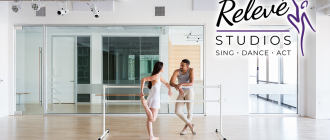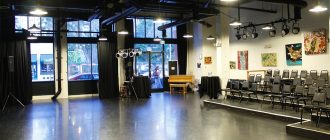- Introduction
- Dancing With
Meet Harout Aristakessian
In the Studio
Harout Aristakessian’s classes are enlivened by his spontaneous creativity, nonjudgmental attitude, and encouragement of personality in students’ styling of the dance.Passionate about the value of self-expression, Harout has a gift for creating a space for dancers to release their inhibitions.
Harout’s sexy, jazz funk-influenced style will have dancers not only strutting and “sitting into it,” but getting down low and really using those leg muscles. And whether he’s teaching choreography or cardio hip hop, his classes are an intense cardio workout!
“It was just passion, sweaty, hot, intense!”
Harout strives to answer questions in class and tailor routines to his students’ abilities, so they can learn and feel accomplished. But as long they’re trying, he doesn’t mind if dancers miss a step or two. What matters most to him is that they use the routine to get in touch with and express themselves.
“I think it’s very important for each individual to add their own style to the choreography, to the movement . . . I expect you to allow yourself to show me yourself through the dance,” Harout says.
And Harout encourages his students to take ownership of the choreography, even standing aside and giving them turns to lead the class in the dance.
Harout‘scardiohip-hop classes at the Glendale YMCA in Glendale, CA are appropriate for beginners and draw exercisers of all ages, from elementary students to seniors. His previous experience includes teaching a hip-hop choreography dance class for adults on staff at Le Studio Dance (part of Pasadena Dance Center) in Pasadena, CA.
Selected Dance Experiences
Millennium Dance Complex
Growing up in Glendale, CA, Harout loved to dance for fun. For a long time, he wanted to take classes at nearby Millennium Dance Complex, but couldn’t afford it. But at 14, he had the opportunity to meet with Millennium’s director, and he received a scholarship.
Harout was both excited and nervous at first, never having trained at a professional studio. But taking class at Millennium almost every day, he soon began to feel at home.
“Luckily, it lasted until I was 19,”Haroutsays of his scholarship. “So I had five years of amazingtraining.“
With the experience he gained at Millennium, Harout was able to begin developing a career just a couple of years into his training.
At 16, he began dancing professionally, booking gigs with artists who had shows at local music venues. His first performance was at West Hollywood’s Troubadour club.
And at 17, he started teaching dance.
“I loved it,” Harout says, “because it was just passion, sweaty, hot, intense!”
Armenian Music Awards
“As a dancer, I like to get out of my comfort zone,” Harout says.
In a performancewith choreographerDarrienHenningat the Armenian Music Awards in December 2009, he did that in more ways than one.
The 7,100-seat Nokia Theatre at L.A.’s Staples Center was packed on the night of the show. Harout felt like he was moving up, dancing at such a large, high-profile event.
During tech rehearsal, he’d walked through the Nokia’s Hall of Fame and seen Shakira and other artists’ pictures. Now he was excited to perform on a stage where so many artists he aspires to dance for had performed before him.
As Harout and Darrien waited backstage, about to go on, suddenly confetti exploded as part of the act before theirs. No one had mentioned confetti, but there it was—all over the stage!
Darrien looked out, Harout says, and told him, “I guess we’re going to have to dance over the confetti.”
“Woo hoo! I better not slip!” Harout thought.
The performance went well, and it aired on an Armenian TV channel in the L.A. area.
Harout’s hometown, Glendale, is in the heart of L.A.’s Armenian community. Almost a year later, Harout says, people who knew him in passing or knew his name—but hadn’t known he was a dancer—were still coming up to tell him they’d seen his performance on TV.
Dancing with Harout Aristakessian
Self-Expression
Self-expression is Harout Aristakessian’s primary focus in class. He views his choreography as a just a scaffolding for class members to build on.
“I let you take my moves and . . . add your flair to it,” Harout says. “Whether it’s a sexy flair, whether it’s a gangster flair—whatever you feel like you need to do to be self-expressive.”
“I love just having fun, and feeling fierce, and
utilizing choreography to dothat.”
Harout’s greatest hope is that his students will be able to shed any self-consciousness and express their unique personality through the dance.
“No inhibitions!” Harout says. “You’re there to have fun.”
Everybody Has a Story
Everybody has a story about themselves, says Harout. Whether it’s that they’re too old to dance, too this or too that, everyone has some constraint that’s holding them down.
“I want to guarantee that anyone who takes my class has fun and that they don’t have that little voice in their head that tells them that they can’t do things,” Harout says. “Because a lot of people have that. And it’s our own voice. It’s not another voice judging us. We’re judging our own selves.”
A dance class isn’t a competition, Harout says. Everybody’s only focused on themselves. How to further their skills, how to challenge themselves. They’re not judging other people. They’re not judging you. And there’s no need foryouto judge yourself, either.
Acting Out a Dance
“I love having premises and using imagery to teach choreography,”Haroutsays.
Teaching to “Telephone” by Lady Gaga one day in an open-level choreography class, he stopped to play part of the song for the dancers, encouraging them to listen to the lyrics and envision the details of the scenario.
Picture your phone ringing over and over while you’re dancing with your friends,Haroutsaid. Imagine how frustrating it is trying to hear someone over the music and noise in the club. Pretend you only have one bar on your phone . . . you can barely hear them anyway. Act out how you annoyed feel about the phone ringing while you’re trying to dance.
When he takes class himself, Harout says, he enjoys having a premise for the dance—like that you’re cocky, or you’re depressed, or you’re a certain character. So he tries to give his students a premise, too.
That Extra Something
Harout is spontaneous in class, sometimes adding freestyle or an extra something to the dance as the hour progresses. He loves to go beyond the choreography to introduce creative elements.
Teaching to “Telephone,” Harout decided to group students into a tight formation at the start of the dance. It would add a realistic element, he said, since the song is about your phone ringing while you’re dancing with friends at the club.
Plus, he said, it would look hot.
Students danced in a close formation from the back of the room to the mirror for the first two eight counts. Then they spread out across the floor as they pretended to reluctantly answer their cell phones.
Having Fun in Class
Harout‘sfavorite style as a choreographer is girly jazz funk,hip-hop-ishpop.
“I love that,”Haroutsays. “Because I love just having fun, and feeling fierce, and utilizing choreography to do that.”
If the students have fun,Haroutsays, that inspires him and he has fun too. He enjoys teaching anyone who comes to class with positive energy and wants to have a good time.
Creativity Unleashed
Harout likes to experiment as a choreographer.
“I always do different levels, I don’t like to just stay up . . . I like to do floor work, I like to do different shapes, different angles, different themes,” Harout says.
For class, he says, sometimes he puts some breaking floor work in a routine, like an easy six step. Other times he does sexy floor work. Once in a while, he teaches a less jazz funk-ish, more hard-hitting routine.
And he’s always thinking about what he can do next that’s different.
“I like to allow my creativity,” Harout says. “I just follow it wherever it takes me.”
Connecting and Communicating
Harout loves to connect with his students. So he strives to introduce himself and ask each person’s name when they walk in.
“Before I start class I say, ‘Ask questions,'” Harout says.
He wants students to feel comfortable talking to him. Hearing feedback after class that’s positive makes him feel like he’s doing his job right. And even if it’s constructive criticism, Harout says, he feels it helps him develop as a person.
Learning Is a Process
Harout wants his new students to leave feeling they’ve accomplished something in class.
When you practice a dance, you’re starting to build muscle memory, he says. It’s a process. So even if they didn’t get the routine down, he hopes people will leave with the mindset of, “It’s my first class. I’m not gonna get it in one class.”
“You have to keep taking class . . . repetition is key,” Harout says.



